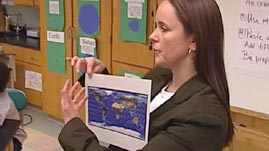Teachers' Domain - Digital Media for the Classroom and Professional Development
User: Preview

Source: WGBH Educational Foundation


A common question for the teaching of science is how to concretize the abstract. However, it is easy to assume that concrete phenomena are just that—easily understood. But when students actually work with the material, it may become too overwhelming in size and scope.
In this light, abstract representations can be a benefit to students’ understanding of the topic. And by working with visuals and graphics, students can learn to master two major components of a science education—skills and content—and meet many state and national education standards in the process.
In her Earth science class shown in this video, teacher Karen Spaulding uses maps and GPS technology to translate the concept of tectonic plate motion to a format that is more easily processed by her students.
Map representations conceptualize such topics in a familiar and enjoyable form—the visual. And by translating concepts and practices between maps and content knowledge, students have the opportunity to visualize and imagine phenomena that occur on a grand scale. Even the concrete ideas students encounter may not be so self-evident, and the education of such concepts can benefit from these kinds of visualizations.
 Loading Standards
Loading Standards